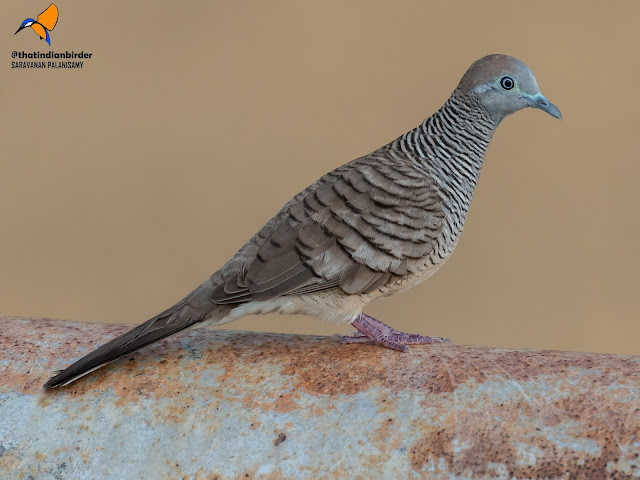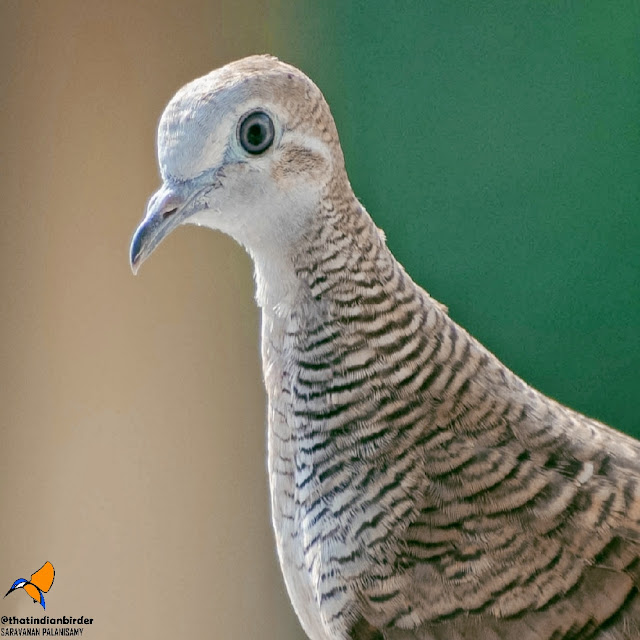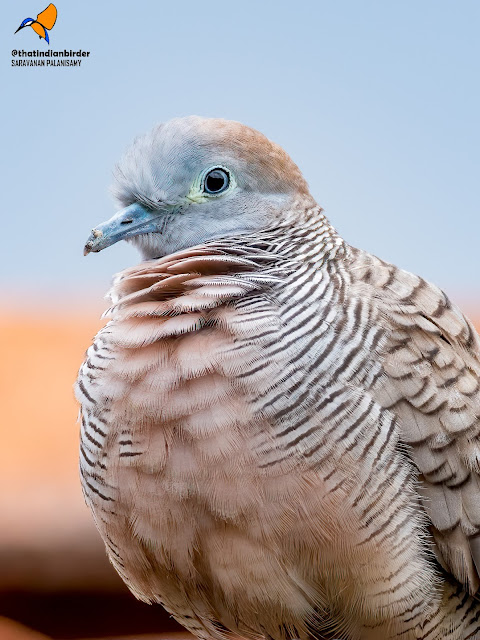Other Names: Barred Ground Dove
Scientific Name: Geopelia striata
Local Name (Malay): Merbuk Aman / Merbuk Balam / Ketitir
Measurements: 20 -23 cm
Zebra doves are one of the many common garden variety birds we have here in Malaysia. Often seen in pairs or in 2 to 3 numbers foraging for seeds on the ground, as its genus implies; "Geo" means ground, and "peleia" means dove (in Greek). The term "striata" refers to its barred (striated in Latin) plumage.
Description:
Zebra doves are small and slender birds with long and narrow tail. Upperpart is brownish grey with black barrings; boldly barred in black on the neck and side of its breast. Underpart is pinkish with black barrings on the side of the belly. Face is grey with bluish "eye ring" skin. It has been mentioned by that adult female zebra doves has a "narrower" pinkish chest plumage compared to those males. As for juveniles, the pinkish chest plumage is absent, replaced by barrings across the breast. Its crown and nape also barred.
Although sexing through plumage had been mentioned for this dove, its always the best done by observing its behavior in the field. Male birds can be distinguished from females through its "bowing" during the courtship and also during copulation. Its usual call is a rapid series of short "coos". It also makes a guttural sound during nesting time. I have also seen some Zebra doves making a rapid tapping sound to warn other doves; its like series of fast beak tapping sound to be exact. Both male and female are good "coo-ers".
Status and Distribution:
Common resident of Peninsular Malaysia, Sabah and Sarawak.
Geographical Variation:
None. Monotypic
Behavior:
Mostly forage for seed on the ground and short grassed plains, either in pairs or in a small group consist of 2 to 4 doves. Some bold enough to get closer to humans. At times joins other birds, such as Rock Pigeons and Eurasian Tree Sparrows feeding on grains fed by humans. Produces "wing whistles" in flight. Mutual grooming had been observed between pairs and (small) group members.
Habitat:
Open country, cultivated land, gardens and parks
Breeding:
Breeding season is from September to June. Male birds court the female by a bowing, raising and spreading the tail. From my observation made, few times when a pair of doves nesting on a hanging flower pot at home, male dove will select a nesting spot and gives out a crackling call to the female; the male then copulates the female.
Nest is build with mesh of plant fibers, roots, small twigs even synthetic broom fibers; in most cases 2 white eggs (at times 3 eggs) are laid. The eggs hatch after 2 weeks of incubation. Incubation is done by both male and female by taking turns. Chicks are fed with crop milk by the parents and later will introduce a proportion of softened adult food. When parents are not at the nest, the chicks will respond to threats by raising up their wings vertically. The chicks will be able to fledge in 2 weeks time and remain around nesting area for few weeks.
Conservation Status:
Least Concern based on IUCN Red List of Threatened Species. Zebra doves are trapped from wild and bred for songbird competitions and commonly sold in pet shops for those who wish to buy and free the birds, in the believe of bad karma removal.
References:
- Craig Robson, 2017, A Field Guide to The Birds of South East Asia, Bloomsbury, London.
- YC Wee, April 2018, Zebra Dove: Adult Male, Female and Juvenile, Bird Ecology Study Group, https://besgroup.org/2018/08/04/zebra-dove-adult-male-female-and-juvenile/
 |
| Zebra Dove - Selangor |
 |
| Zebra Dove - Selangor |
 |
| Zebra Dove nest on a hanging pot at home |
 |
| Zebra Dove nestling in threat pose |
 |
| An immature Zebra Dove - Selangor |
 |
| Zebra Dove - Selangor |
 |
| Zebra Dove - Selangor |

Recently has a nest and 2 chicks hatched on 15th day of chinese new year.
ReplyDeleteNice! :)
Delete
ReplyDeleteIn manuk-manuk ini, bukun sadja kakitaan ha Malaysia sah, kakitaan isab ini ha manga pangdaig hulah ha Asia-Tunggarah saparti Indonesia, Pilipin, Brunei, Thailand iban Cambodia.
Daypara, mahunit ingatun bang hain ka in babai atawa usug. Malingkat tuud sa in content mu. Magsukul sin pagdihil pangingat
Magsukul tuud.
Delete